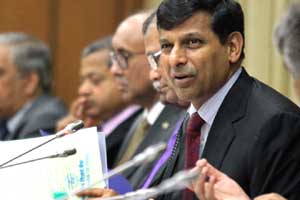Even as he surprised the street with a 50-basis-point cut in the key policy rate, and a doveish stance, Reserve Bank of India (RBI) governor Raghuram Rajan on Thursday indicated the government would need to do its bit to help banks pass on the cuts.
Saying it was “frontloading” rates using the room available with it for monetary easing with a view to kick starting demand, the central bank trimmed the repo rate by half a percentage point to 6.75%. Both the stock and bond markets rallied, with benchmark yield closing 11 basis points lower at 7.61%.
“While the RBI’s stance will continue to be accommodative, the focus of monetary action, for the near term, will shift to working with the government to ensure that impediments to banks passing on the bulk of the cumulative 125 basis points cut in the policy rate are removed,” Rajan said, making it evident returns on small savings schemes needed to be brought down so that there was a level playing field between these and bank deposits.
For its part, Rajan said the central bank is changing regulations relating to the manner in which the base rate is calculated to help banks. Moreover, it would make sure liquidity is ample such that the overnight rate is as close to the repo rate as possible.
The RBI lowered its inflation forecast marginally to 5.8% for January 2016 from 6%, citing lower oil prices.
However, it simultaneous pared its projection for growth recovery to 7.4% in FY16 down from 7.6% in August due to, inter alia, weaker global growth and weak investment momentum in the private sector.
“A tentative economic recovery is under way but is still far from robust,” Rajan observed, adding that “corporate intention” to invest had not picked up.
Abheek Barua, chief economist, HDFC Bank, pointed out the central bank’s emphasis was on external headwinds to the domestic economy from weak global growth prospects, especially emerging markets, their impact on suppressing global trade volumes and India’s export momentum as well as keeping commodity prices low.
Economists at Crisil expect a prolonged pause from here on, noting the central bank would watch for demand-side pressures on inflation arising from the Seventh Pay Commission payouts. “The RBI has also set the CPI inflation target at 5% by end 2016-17 and reiterated it at 4% by end 2017-18. Therefore, the pause from hereon could be a prolonged one unless there is a significant positive surprise on inflation,” they said.
The RBI explained the 50-bps cut saying inflation had dropped to a nine-month low, as projected. Moreover, commodity prices were expected to stay contained given the global growth had moderated in August. Also, the rise in food prices had been reined in despite the deficiency in the monsoon rainfall. “The disinflation has been broad-based and inflation excluding food and fuel has also come off its rate peak in June,” the governor said.



